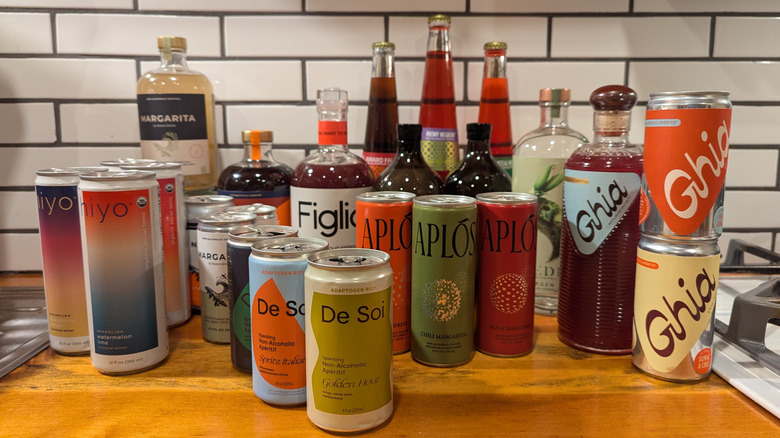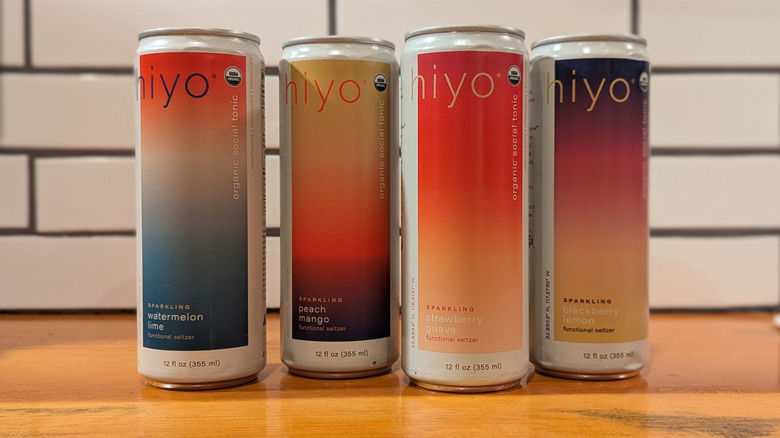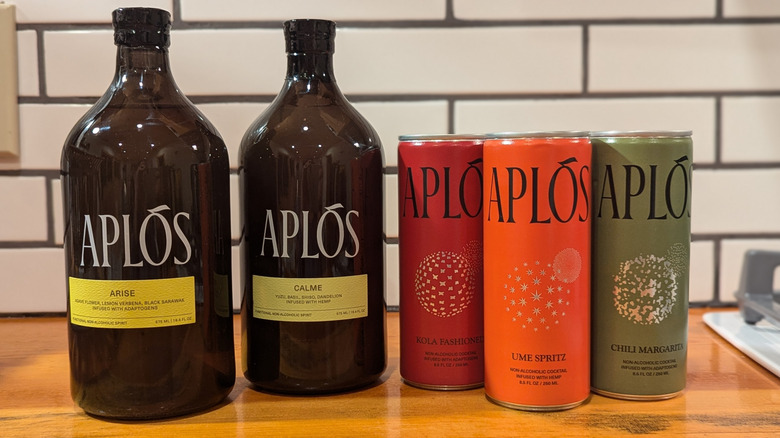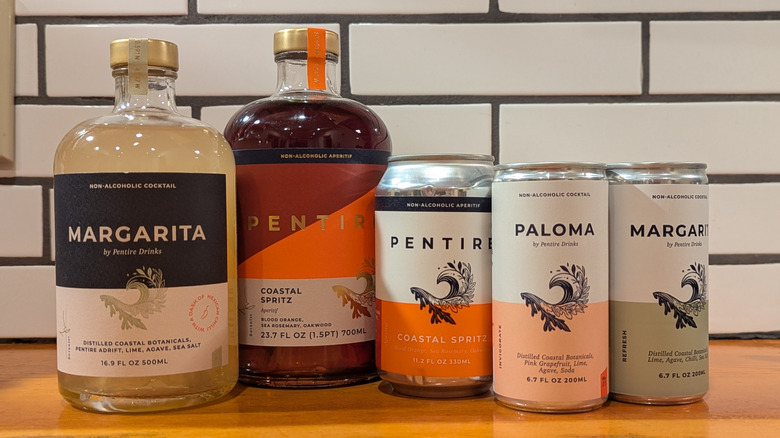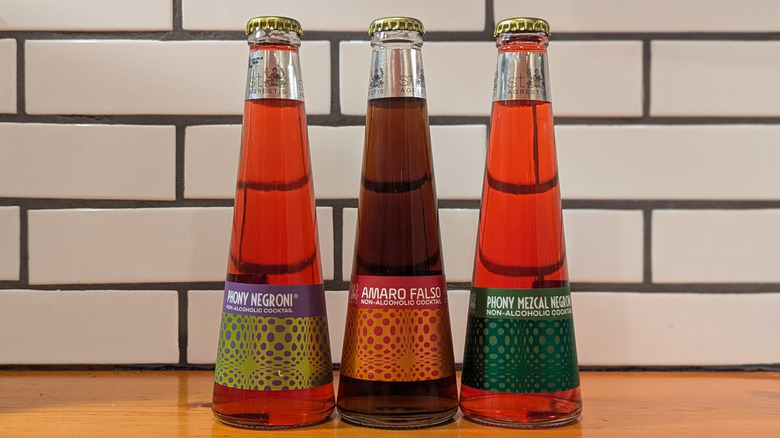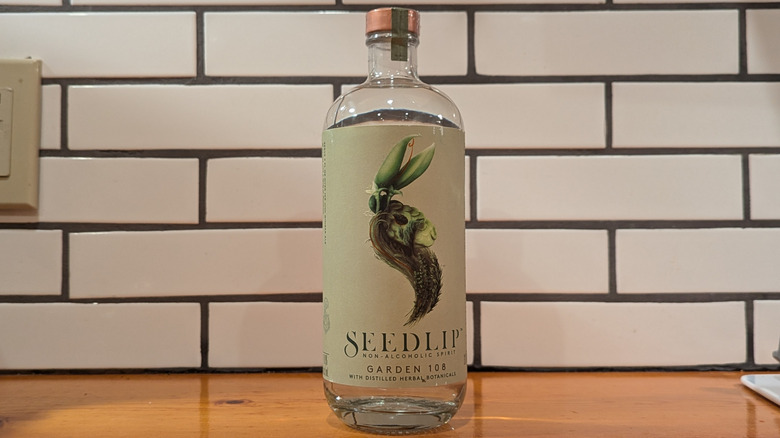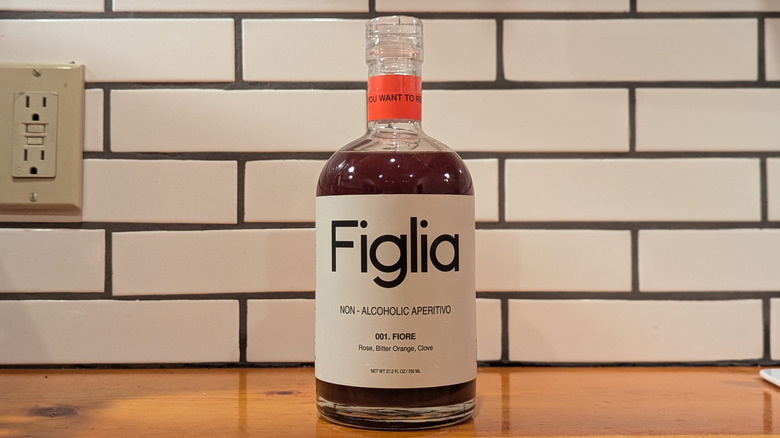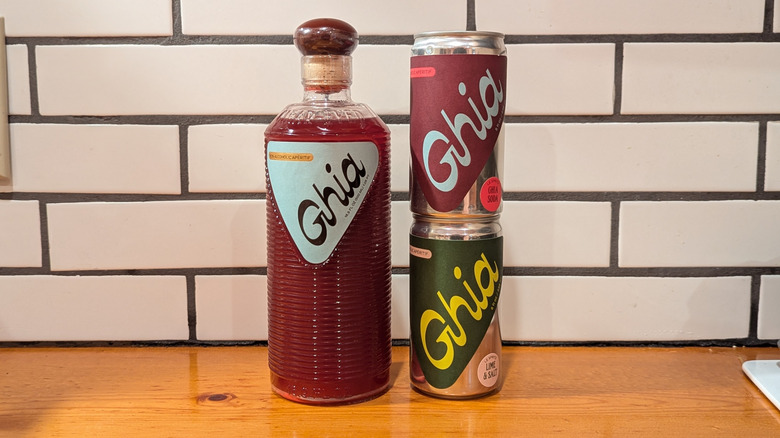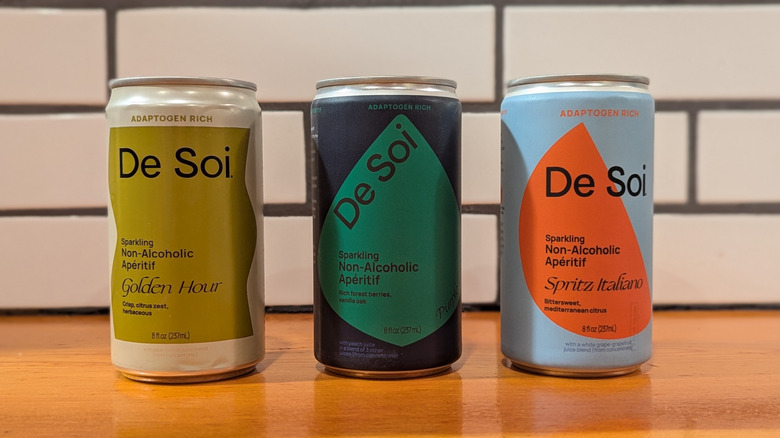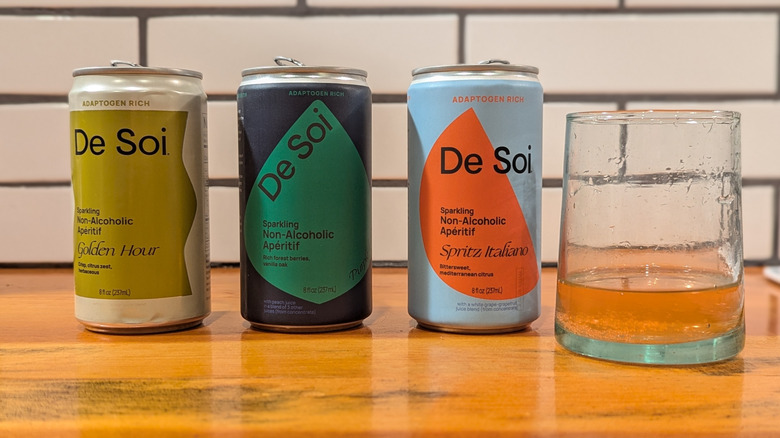8 Non-Alcoholic Aperitifs, Ranked
The creative and non-alcoholic drink scene has boomed in recent years, and I'm here for it. While I'm a natural wine sommelier, I've also loved seeing the non-alcoholic industry grow with gusto. There is room on the shelf for all drinks and certainly a time and place for each. Likely my favorite moment for a cocktail is when golden hour hits. Splashing a drink together is such a lovely way to transition your day to evening, any night of the week.
The wide variety of non-alcoholic aperitifs that have entered the market over the last couple of years makes it easy to enjoy something special without the boozy side effects that follow. Whether you're sober curious, off alcohol entirely, or in the middle of dry January, leaning into the realm of non-alcoholic aperitifs doesn't mean you're missing out. I find the creativity behind many of the drinks playful and intriguing, with numerous brands finding a niche to please a wide variety of palates.
I tried eight brands that are currently on shelves, many of which have numerous flavors or are renditions of cocktails. Traditional aperitifs lean toward herbaceous and botanical bitter notes. I considered this and ranked each brand on balance, tasting for layers of complexity in each and looking for those key botanical notes. I also considered overall drinkability and whether or not the beverage could hang as an aperitif versus simply falling into the generic non-alcoholic drink category.
Some recommendations are based on first-hand impressions of promotional materials and products provided by the manufacturer.
8. Hiyo
Hiyo comes in four bold and fruity flavors, each in a 12-ounce can. The brand's vibe seems to be geared toward a sweet-loving palate. The drinks are 9% juice-based, and while they contain adaptogens, nootropics, and botanicals, there is also erythritol, an artificial sweetener. I tried all four flavors: watermelon lime, blackberry lemon, strawberry guava, and peach mango.
While the strawberry guava really leaned into its namesakes in both aroma and flavor, the peach mango came across a bit more generic, giving island tropical with a tiny, colorful umbrella. The blackberry lemon had the most complexity of all, thanks to the slight hint of lemon balm.
All the Hiyo flavors were intensely aromatic and charged with flavor compounds, though I found they tasted more like a Jolly Rancher than anything in the realm of aperitif beverages. The artificialness of each was really pronounced, from the vibrant colors to the watermelon candy sweetener that lingered on my tongue. Hiyo is not for me, and I could only drink a few sips before maxing out. In my opinion, an aperitif needs to read more complex with varied bitter notes that start to prepare your palate and appetite for the next portion of the evening. Hiyo felt like a good substitute for a non-alcoholic White Claw – overly sweet, very basic, and not well-balanced.
7. Aplós
Aplós had a few hits, but most were a miss compared to the rest of the non-alcoholic aperitifs I sampled. Aplós makes two versions of a concentrate aperitif intended to be mixed with sparkling water. The first is Arise, which is edgier than its evening counterpart, Calme. Arise contains agave flower, lemon verbena, and black Sarawak peppercorns. It has distinct aromas of cucumber with a balanced profile, heavy in the citrus with hints of black pepper and an astringency you want and expect from an aperitif. Calme is a yuzu, basil, dandelion, shiso, and hemp concoction intended for mixing. It features perfumed botanicals that are somewhat artificial, and the hemp is overpowering, leaving a soapy sensation in the mouth.
Aplós also makes three flavors of pre-mixed spritz cans. Ume Spritz is a mix of white tea, sweet basil, hemp, and cucumber. While it's not offensive, it comes across a bit too perfumed and I couldn't imagine wanting to drink a whole can. The Kola Fashioned sounded most interesting but missed the mark in the tasting. The smoked cherry wood came across like overwhelming peat and it was quite unpleasant. Finally, the Chili Margarita, which is a mix of kaffir lime, chili, peppercorns, and lemon verbena, was a win. Again, it was fairly aromatic, but the flavors played out well with good acidity. Not only did I think the drink had the best overall flavor profile, but I also found it to be the best substitute for an actual aperitif or cocktail. Overall though, the line-up from Aplós could be more dialed in.
6. Pentire Drinks
The British company Pentire Drinks makes five flavors, some in a larger format and others in ready-to-drink 200- to 330-millileter cans. I tried the Coastal Spritz, Margarita, and Paloma iterations.
The Coastal Spritz was complex with big citrus notes of orange, blood orange, and orange zest paired with bitter medicinal notes and a bit of oak. It was fresh, well-balanced, and had a depth of flavor that made it a great non-alcoholic aperitif or cocktail substitute. Popping the top and pouring the Margarita was wild, as it immediately gave off intensely overwhelming aromas that I do not associate with a traditional citrus-driven Margarita. While there were initial notes of lime, the aromas and flavors strongly featured sage, fresh soil, wood, and muskiness. It was quite overwhelming, unexpected, and unpleasant, with a lingering citric sharpness that left a harsh finish.
Thankfully, the third flavor was a win. The Paloma smelled and tasted fresh, bright, complex, and delicious. With strong notes of tart and juicy grapefruit, this aperitif was flavorful while balancing sweet and sour notes. The addition of seaweed extract infused a pleasant saltiness while the distilled coastal botanicals added depth to the citrus-forward beverage. While the bizarre Margarita drink was a big miss, Pentire Drinks really comes through with the Coastal Spritz and Paloma, which are a great non-alcoholic aperitif, beach bevvy, or cocktail substitute.
5. St. Agrestis
Soon after the Italian-inspired Phony Negroni was born in Brooklyn, NY, it was popping up on shelves everywhere, and for good reason. Brothers Louis and Matt Catizone have a rich family history built around Italian culinary traditions. Drinking the classic Italian bitter sodas since childhood inspired them to create St. Agrestis.
The heart of the brand is the Phony Negroni, a distilled, non-alcoholic Negroni doppelgänger in a personal-sized angular bottle. The red-hued non-alcoholic negroni consists of a lengthy compilation of wild herbs, roots, citrus, and spices, resulting in a layered profile rich in negroni-esque notes. The slight carbonation mimics the sensation and textural effect of alcohol on the tongue. And while I find the Phony Negroni a bit on the sweet side, it replicates the flavor and textural profile of a true negroni remarkably well.
The other non-alcoholic beverages from St. Agrestis are the Amaro Falso and Mezcal Negroni. The first has distinct aromas of cola and some similarities to amaro, but for me, it was lacking in bitterness and needed a bit more zip. Mezcal can bring smoky notes to a cocktail, but the smoke aromas in this Mezcal Negroni were strong enough that I found it a bit off-putting. Thankfully, in the glass, the smoke isn't as overwhelming on the nose, however, it is a bit sweet and could use more acidity and bitter components to layer depth. As for the color, it's wildly vibrant with an artificial look I didn't much enjoy.
4. Seedlip
When it comes to the world of non-alcoholic drinks, Seedlip is a name that's been on the block for a while. Now with four different flavors, the distilled non-alcoholic offerings lean more toward a spirit substitute than anything else.
The Spice 94 blend is a warming combination of citrus and autumnal spices, while the Grove 42 leans into brighter Mediterranean citrus and ginger notes. The Garden 108 is an herbaceous infusion full of tender aromatics and fresh-cut kitchen garden greenery. The latest addition to its lineup is the Notas de Agave, which combines lime, agave, and spicy peppercorns. All of the above have deeply concentrated flavor profiles that are good foundations for building non-alcoholic aperitifs and cocktails with distinct complexity and character.
The Garden 108 is particularly delicious with fresh botanical aromas of juniper, spearmint, and pea shoots (which are all also nice garnish ideas). The beauty of Seedlip's concentrated non-alcoholic drinks is that they offer the flexibility to create whatever drink suits your mood. Garden 108 with a splash of ginger ale over ice makes a great pre-dinner aperitif. Alternatively, you can easily build a more involved drink with Seedlip's foundational flavors as the base. Overall, the Seedlip lineup is well-balanced, complex, and high-quality. In the world of non-alcoholic options, it's worth exploring and playing with a few of its offerings. It would be great if there was a ready-to-drink canned version for an easy and transportable option.
3. Figlia
I only recently heard about Figlia and was immediately drawn to the brand through its tender marketing story. It's a non-alcoholic aperitif built after the loss of a loved one to alcoholism. The brand creates space for a 5 p.m. spritz that can be enjoyed by a wider community.
Figlia offers two products. The first, Fiore, is a non-alcoholic aperitivo concentrate in a large format 750-milliliter bottle, intended to be spritzed over ice. With a vibrant shade of ripe strawberry, Fiore displays initial aromas of rose petal, bitter orange, blackcurrant, clove, and a hint of ginger, all of which carry over onto the palate. The second product is an 8.4-ounce can of Fiore Frizzante. This little gem combines the concentrate with effervescent bubbles for a perfectly bittersweet and lively non-alcoholic spritz that is everything you want it to be.
Figlia really strikes the balance between pretty florals, bitter roots, and bright citrus, giving up a satisfyingly non-alcoholic aperitif full of character. And while there's only one flavor profile offered, I find the focus on the singular option refreshing in a world of choice. The concentrate allows for a little creativity on your part while the ready-to-drink can is a quick, convenient option to pack for a picnic or pop open at the beach. Each conjures up sun-drenched feelings of Italy in the summertime with friends. What's lovelier than that?
2. Ghia
Ghia is another non-alcoholic aperitif that has been around for a while and can be found in more and more shops and restaurants. With the spritz and the spirit of the Mediterranean in mind, Ghia combines white grape juice concentrate with a splash of yuzu juice and a whole lot of flavorful and bitter inclusions like gentian root, rhubarb root, and rosemary extract. The original concentrate has a lot of oomph and balances bitter, sweet, and savory notes. Combining the concentrate with tonic or something sparkling builds a tasty aperitif you'll want to sip over ice year-round.
Beyond the original Ghia, the brand now offers four flavor profiles of pre-spritzed, ready-to-drink 8-ounce cans: Ghia soda (the original), Ghia Ginger, Sumac & Chili, and Lime & Salt. Each of the cans is a great iteration and expression of the flavors, with the Sumac & Chili being the most unique with its vibrant citrus, strawberry, and yuzu notes and big kick of spice. I have to also give special mention to the Lime & Salt, which combines zesty lime juice with a depth of extracts and a subtle but present dash of sea salt. A salted rim can lift up any cocktail, and this flavor really channels a warm beach day, with a refreshing, salted-rimmed drink in hand, condensation droplets building.
I want to drink Ghia as is and also play with it as a foundation to build other drinks on. It's fresh, inspired, and well-balanced, and each flavor rings through in an authentic and approachable way.
1. De Soi
De Soi was a new-to-me canned aperitif and an unexpected joy to sip. Born from a collaboration that is 50% Katy Perry, the little 8-ounce cans offer up some delicious flavors in non-alcoholic form. De Soi has four staple flavors with an occasional limited edition offering, each with a distinct character. Adaptogens are an ever-popular addition to drinks, and that's true of these, infused with ingredients like reishi mushroom, lion's mane, and L-theanine.
Golden Hour has strong ginger ale aromas paired with yuzu and lemongrass. It has the quintessential bitter edge of a traditional aperitif, with slight medicinal notes from lemon balm and chamomile. It's fresh, herbaceous, crisp, and more complex than most in its field, which I liked. Purple Lune plays into much richer dark fruit notes with hints of vanilla. The bold color hints at the textured profile with pronounced notes of blackcurrant, blackberry, Italian plum, and balsamic vinegar. The inclusion of vanilla makes it especially full-bodied, giving a sort of cream-soda feel. It's quite unique with good acidity and balance.
The traditional take on a Spritz Italiano is more classic, with the perfect mix of bittersweet Mediterranean citrus notes coming through in an orange-forward manner. The gentian root makes it feel familiar as far as spritzes go, and the notes of sherbert and grapefruit bring a bright energy. It's familiar, approachable, and fresh. All in all, De Soi really brings quality. The line-up is a great range of interesting drinks that I'm eager to seek out again and again.
Methodology
With all the non-alcoholic beverages and aperitifs on the market, there was no shortage of drinks to taste. I focused on some brands that have been around for awhile, as well as a few that are newer to the game, tasting each product for overall balance, interest, and drinkability. I ranked the eight brands based on the quality of their offerings, looking for that lip-smacking characteristic that comes with a classic aperitif. In the end, there were a few that missed the mark and others that served up something special. I received products from a number of brands to write this review, but all thoughts and opinions are my own.
